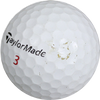Every now and then someone hurts our feelings by calling our balls “waterlogged.” But we understand their concern. People are skeptical about how balls that may have spent months underwater perform. A lot of people, including us, have done testing on this. The results are almost always consistent, showing no appreciable difference in play between new and mint-quality, used golf balls.
But still, a ball can’t sit at the bottom of a pond forever without something happening. Right? So, we decided to find out just how long by being the first to commission a university-run, independent research study. The goal? To compare the performance of brand new golf balls with balls that have spent 1-month and 3-months at the bottom of a real, live golf course pond.

So just how long can a ball spend underwater before something happens to it? We still don’t know. All the balls – new, 1-month and 3-months underwater – performed almost identically in a whole bunch of tests measuring distance, speed, spin, trajectory and more. They all followed the same flight path. Carry and total distance with roll was almost identical for all balls, and they all ended up within a few yards of each other on the course. See dispersion map below showing final landing place of new balls and balls submerged for 3 months.
Trackman data showing final position on course of new balls and balls submerged for 3 months after being hit by robotic driver
So, we’'re just going to have to keep testing. And if you want the details of the research, including all the actual test data, just go here.




